|
News Archive: August 1-31 |

|
Lockheed Martin to build NASA's CEV spacecraft
America's next manned spacecraft, the wingless successor to the space shuttle that will carry astronauts to and from the international space station and eventually back to the moon, will be built by Lockheed Martin Corp. under contracts valued at up to $8.15 billion, NASA announced Thursday.
 FULL STORY FULL STORY
 NASA STATEMENT NASA STATEMENT
 |  |
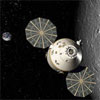
|
 |

Additional coverage for subscribers:
 VIDEO:
ORION BUILDER UNVEILED DIALUP | BROADBAND VIDEO:
ORION BUILDER UNVEILED DIALUP | BROADBAND
 SUBSCRIBE NOW SUBSCRIBE NOW

|
Hubble captures a rare eclipse on Uranus
This image is a never-before-seen astronomical alignment of a moon traversing the face of Uranus, and its accompanying shadow. The white dot near the center of Uranus' blue-green disk is the icy moon Ariel as the 700-mile-diameter satellite casts a shadow onto the cloud tops of the planet. To an observer on Uranus, this would appear as a solar eclipse, where the moon briefly blocks out the Sun.
 FULL STORY FULL STORY
 |  |

|
 |
Atlantis launch officially rescheduled for next week
NASA managers today formally selected Wednesday, September 6 as the new target launch date for shuttle Atlantis after inspections revealed no damage from tropical depression Ernesto's encounter with Kennedy Space Center. Liftoff is set for 12:28:49 p.m. EDT.
 MISSION STATUS CENTER MISSION STATUS CENTER
 |  |

|
 |
Supernova caught in the act
Scientists using NASA's Swift satellite and a combination of orbiting and ground-based observatories have for the first time caught a supernova in the act of exploding.
 FULL STORY FULL STORY
 |  |

|
 |
Shuttle launch window extended to Sept. 8
NASA and Russian space managers agreed today to extend the shuttle Atlantis' launch window by one day, to Sept. 8, to bolster the U.S. space agency's chances of getting the weather-delayed shuttle off the ground this month.
 FULL STORY FULL STORY
 |  |

|
 |
Atlantis could be ready to launch by next week
If shuttle Atlantis weathers tropical storm Ernesto without any major problems, and if engineers can complete hurried preparations, NASA may be ready to make a launch attempt as early as Sept. 6, one day before the shuttle's launch window closes, officials said late Tuesday.
 FULL STORY FULL STORY
 ROLLBACK REVERSED ROLLBACK REVERSED
 EARLIER STORY EARLIER STORY
 |  |

|
 |

Additional coverage for subscribers:
 VIDEO:
NEWS BRIEFING ON RETURN TO PAD DIALUP | BROADBAND VIDEO:
NEWS BRIEFING ON RETURN TO PAD DIALUP | BROADBAND
 VIDEO:
ATLANTIS ROLLBACK BEGINS PART 1 | PART 2 VIDEO:
ATLANTIS ROLLBACK BEGINS PART 1 | PART 2
 MORE: STS-115 VIDEO COVERAGE MORE: STS-115 VIDEO COVERAGE
 SUBSCRIBE NOW SUBSCRIBE NOW

|
NASA reconsiders its daylight launch rule
If the shuttle Atlantis fails to get off the ground before the Sept. 7 end of its current launch window - a scenario that could delay the flight to late October - NASA managers may reconsider an earlier decision to only launch in daylight.
 FULL STORY FULL STORY
 |  |

|
 |
Crawler problems add hours to rollback time
Problems with one of NASA's ponderous crawler-transporters will force engineers to take the shuttle Atlantis to the far side of the Vehicle Assembly Building Tuesday if a rollback from the launch pad is ordered because of tropical storm/hurricane Ernesto. The change in plans will add three hours or so to the time necessary to get Atlantis out of harm's way.
 FULL STORY FULL STORY
 MISSION STATUS CENTER - live updates! MISSION STATUS CENTER - live updates!
 |  |

|
 |
Storm forces rollback preparations to begin
In what amounts to a "perfect storm" of high winds, high stakes and international drama, tropical storm Ernesto threatens to bring hurricane-force winds to the Kennedy Space Center by Wednesday night. NASA managers Monday ordered engineers to begin work to roll the shuttle Atlantis off its seaside launch pad Tuesday, raising the prospect of a lengthy launch delay.
 FULL STORY FULL STORY
 |  |

|
 |
NASA defers Atlantis rollback decision to Monday
NASA managers met Sunday evening and agreed to wait until Monday morning to make a decision on whether to roll the shuttle Atlantis back to the Vehicle Assembly Building, preserving for now the option of launching the ship Tuesday on a space station assembly mission.
 FULL STORY FULL STORY
 MID-DAY STORY MID-DAY STORY
 MORNING STORY MORNING STORY
 LAUNCH WINDOWS CHART LAUNCH WINDOWS CHART
 |  |

|
 |

Additional coverage for subscribers:
 VIDEO:
SUNDAY EVENING MANAGEMENT UPDATE PLAY VIDEO:
SUNDAY EVENING MANAGEMENT UPDATE PLAY
 VIDEO:
OFFICIALS EXPLAIN INITIAL SCRUB PLAY VIDEO:
OFFICIALS EXPLAIN INITIAL SCRUB PLAY
 VIDEO:
SEE THE LIGHTNING STRIKE AT PAD B PLAY VIDEO:
SEE THE LIGHTNING STRIKE AT PAD B PLAY
 VIDEO:
ANOTHER VIEW OF LIGHTNING STRIKE PLAY VIDEO:
ANOTHER VIEW OF LIGHTNING STRIKE PLAY
 VIDEO:
PRE-LAUNCH NEWS CONFERENCE PLAY VIDEO:
PRE-LAUNCH NEWS CONFERENCE PLAY
 MORE: STS-115 VIDEO COVERAGE MORE: STS-115 VIDEO COVERAGE
 SUBSCRIBE NOW SUBSCRIBE NOW

|
Solid rocket booster tests could be ordered
NASA's Mission Management Team decided early Sunday to continue testing and analysis to assess the possible effects of a launch pad lightning strike Friday on the shuttle Atlantis' solid-fuel booster and self-destruct systems. A Monday launch attempt remains feasible for now, sources said, but only if the community agrees time-consuming tests to verify the health of booster and range safety pyrotechnic systems are not needed. If the tests are required, launch likely would slip to mid week or later.
 FULL STORY FULL STORY
 |  |

|
 |
Lightning delays Atlantis launch at least a day
The lightning bolt that hit launch pad 39B Friday was one of the most powerful on record at the Kennedy Space Center, sending some 100,000 amps of current through the lightning protection system, officials said Saturday. While the lightning protection system worked, shielding the shuttle Atlantis from a direct hit, engineers are concerned about induced currents that showed up in a brief spike in one of the shuttle's main circuits and another in a launch pad pyrotechnic system.
 FULL STORY FULL STORY
 EARLIER STORY EARLIER STORY
 UPDATED WEATHER FORECAST UPDATED WEATHER FORECAST
 |  |

|
 |
Successful first step for Bigelow's plans in space
Bigelow Aerospace is preparing for a "major course change" after a wildly successful first month in orbit for the maiden test flight of their prototype inflatable space module, the company's founder said Friday.
 FULL STORY FULL STORY
 |  |

|
 |
Station construction to resume with Atlantis
The shuttle Atlantis is poised for blastoff on a long-awaited flight to restart assembly of the international space station three years after the Columbia disaster derailed construction. Atlantis and its six-person crew will deliver a $372 million set of solar arrays to the outpost, kicking off the most ambitious series of manned space flights since the Apollo moon program. This is our 16,000-word preview of Atlantis' mission.
 FULL REPORT FULL REPORT
 |  |

|
 |

Additional coverage for subscribers:
 VIDEO:
FRIDAY'S COUNTDOWN STATUS DIAL-UP | BROADBAND VIDEO:
FRIDAY'S COUNTDOWN STATUS DIAL-UP | BROADBAND
 VIDEO:
COMPLETE PREVIEW OF ATLANTIS MISSION PLAY VIDEO:
COMPLETE PREVIEW OF ATLANTIS MISSION PLAY
 VIDEO:
DETAILS OF THE THREE SPACEWALKS PLAY VIDEO:
DETAILS OF THE THREE SPACEWALKS PLAY
 VIDEO:
MEET THE SIX ASTRONAUTS PLAY VIDEO:
MEET THE SIX ASTRONAUTS PLAY
 MORE: STS-115 VIDEO COVERAGE MORE: STS-115 VIDEO COVERAGE
 SUBSCRIBE NOW SUBSCRIBE NOW

|
NASA working around stormy weather at the Cape
A lightning bolt struck near the space shuttle Atlantis Friday as powerful thunderstorms rolled across the Kennedy Space Center, but the launch pad lightning protection system shielded the orbiter and officials said the countdown was on track for a Sunday launch try, weather permitting.
 FULL STORY FULL STORY
 |  |

|
 |
Solar system shrunk
If you woke up Thursday morning and sensed something was different about the world around you, you're absolutely right. Pluto is no longer a planet. The International Astronomical Union, wrapping up its meeting in Prague, Czech Republic, has resolved one of the most hotly-debated topics in the cosmos by approving a specific definition that gives our solar system eight planets, instead of the nine most of us grew up memorizing.
 FULL STORY FULL STORY
 |  |

|
 |
Atlantis crew arrives as countdown begins early
The shuttle Atlantis' astronauts flew to Florida Thursday to prepare for launch Sunday on a long-awaited flight to restart space station assembly. With forecasters predicting a 70 percent chance of good weather, liftoff from pad 39B is targeted for 4:30 p.m. Sunday.
 FULL STORY FULL STORY
 LAUNCH WEATHER FORECAST LAUNCH WEATHER FORECAST
 |  |

|
 |

Additional coverage for subscribers:
 VIDEO:
CREW ARRIVES FOR LAUNCH PLAY VIDEO:
CREW ARRIVES FOR LAUNCH PLAY
 VIDEO:
THURSDAY'S COUNTDOWN STATUS DIAL-UP | BROADBAND VIDEO:
THURSDAY'S COUNTDOWN STATUS DIAL-UP | BROADBAND
 SUBSCRIBE NOW SUBSCRIBE NOW

|
Galaxy hunter: Giant black holes stifle star birth
Supermassive black holes in some giant galaxies create such a hostile environment, they shut down the formation of new stars, according to NASA Galaxy Evolution Explorer findings published in the new issue of Nature.
 FULL STORY FULL STORY
 |  |

|
 |
Wispy dust and gas paint portrait of starbirth
This active region of star formation in the Large Magellanic Cloud (LMC), as photographed by NASA's Hubble Space Telescope, unveils wispy clouds of hydrogen and oxygen that swirl and mix with dust on a canvas of astronomical size. The LMC is a satellite galaxy of the Milky Way.
 FULL STORY FULL STORY
 |  |

|
 |
Crew Exploration Vehicle given the name Orion
NASA announced Tuesday that its new Crew Exploration Vehicle will be named Orion. The craft is being developed to carry a new generation of explorers back to the moon and later to Mars. Orion will succeed the space shuttle as NASA's primary vehicle for human space exploration.
 FULL STORY FULL STORY
 |  |

|
 |
SMART-1 on the trail of the Moon's beginnings
An instrument on ESA's Moon mission SMART-1 has produced the first detection from orbit of calcium on the lunar surface. By doing this, the instrument has taken a step towards answering the old question: did the Moon form from part of the Earth?
 FULL STORY FULL STORY
 |  |
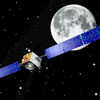
|
 |
OTHER HEADLINES Additional stories today
|
 |
Space pioneers to be recognized, honored -- Gen. Kevin P. Chilton, Air Force Space Command commander, will induct six people into the Air Force Space and Missiles Pioneers Hall of Fame August 24 during an induction ceremony at the Air Force Space Command Headquarters Building.

Orbital ships Optus D1 satellite to launch site -- Orbital Sciences Corporation announced that the company-built Optus D1 geosynchronous communications satellite has been delivered to the space launch complex in Kourou, French Guiana, where it is scheduled to be launched aboard an Arianespace Ariane 5 rocket in September.
|
 |
Satellite with double use launched for South Korea
South Korea's first dual-use commercial and military communications satellite is now in space after a successful blastoff from a floating platform in the central Pacific Ocean. A Sea Launch Zenit 3SL rocket lofted the Koreasat 5 spacecraft Monday night.
 FULL STORY FULL STORY
 MISSION STATUS CENTER MISSION STATUS CENTER
 CUE CARD DATA SHEET CUE CARD DATA SHEET
 |  |

|
 |
NASA finds direct proof of that dark matter exists
Dark matter and normal matter have been wrenched apart by the tremendous collision of two large clusters of galaxies. The discovery, using NASA's Chandra X-ray Observatory and other telescopes, gives direct evidence for the existence of dark matter.
 FULL STORY FULL STORY
 |  |
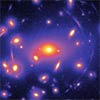
|
 |
Japanese space tourist grounded by doctors
Undisclosed medical reasons have bumped would-be space tourist Daisuke "Dice-K" Enomoto from his planned ride to the International Space Station. The 34-year-old Japanese entrepreneur was supposed to launch Sept. 14 aboard a Russian Soyuz rocket with the station's Expedition 14 crew for a week-long stay on the outpost. A replacement, possibly Anousheh Ansari, will be confirmed in the coming days.
 |  |

|
 |
Launch of Sun-watching mission delayed again
Continuing concerns about the structural integrity of the Boeing Delta 2 rocket's second stage that will launch NASA's twin STEREO solar observatories have again delayed liftoff from Cape Canaveral. Problems with a similar stage in the factory led engineers to re-check the motor for STEREO, pushing back the launch to Aug. 31. Now, launch is being delayed to no sooner than Sept. 18. Although STEREO's rocket has passed its testing, further analysis is underway to ensure the internal tank structures are the proper thickness.
 |  |

|
 |
Voyager 1 passes milestone
Voyager 1, already the most distant human-made object in the cosmos, has reached 100 astronomical units from the sun. That means the spacecraft, which launched nearly three decades ago, is 100 times more distant from the sun than Earth is. In more common terms, Voyager 1 is about 9.3 billion miles from the sun.
 FULL STORY FULL STORY
 |  |

|
 |
NASA selects crew, cargo launch partners
NASA has picked SpaceX and Rocketplane-Kistler to develop and demonstrate commercial orbital transportation services that could open new markets and pave the way for contracts to launch and deliver crew and cargo to the International Space Station.
 FULL STORY FULL STORY
 |  |

|
 |

Additional coverage for subscribers:
 VIDEO:
COTS WINNERS ANNOUNCED DIAL-UP | BROADBAND VIDEO:
COTS WINNERS ANNOUNCED DIAL-UP | BROADBAND
 SUBSCRIBE NOW SUBSCRIBE NOW

|
Hubble images some of galaxy's dimmest stars
Using the Hubble Space Telescope, astronomers have imaged some of the galaxy's oldest and dimmest stars, offering a rare experimental glimpse of two mysterious star types tiny, slow burners less than one-tenth the size of our sun and once giant stars that still glow more than 10 billion years after their deaths.
 FULL STORY FULL STORY
 |  |

|
 |
Mystery of Quintuplet stars in Milky Way solved
For the first time, scientists have identified the cluster of Quintuplet stars in the Milky Way's galactic center, next to the super massive black hole, as massive binary stars nearing the end of their life cycle, solving a mystery that had dogged astronomers for more than 15 years.
 FULL STORY FULL STORY
 |  |

|
 |
Gas jets spawn mystery spots on Mars icecap
Every spring it happens. As the Sun peeks above the horizon at the Martian south polar icecap, powerful jets of carbon-dioxide gas erupt through the icecap's topmost layer. The jets climb high into the thin, cold air, carrying fine, dark sand and spraying it for hundreds of feet around each jet.
 FULL STORY FULL STORY
 |  |

|
 |
Readiness review clears Atlantis pending final issues
NASA managers Wednesday formally - and unanimously - cleared the shuttle Atlantis for blastoff Aug. 27 on a mission to restart space station assembly, pending resolution of two down-to-the-wire technical issues.
 FULL STORY FULL STORY
 EARLIER COVERAGE EARLIER COVERAGE
 MASTER FLIGHT PLAN MASTER FLIGHT PLAN
 LAUNCH WINDOWS CHART LAUNCH WINDOWS CHART
 MISSION QUICK-LOOK: Page 1 | Page 2 MISSION QUICK-LOOK: Page 1 | Page 2
 REMAINING SHUTTLE LAUNCH SCHEDULE REMAINING SHUTTLE LAUNCH SCHEDULE
 |  |

|
 |

Additional coverage for subscribers:
 VIDEO:
LAUNCH DATE ANNOUNCEMENT NEWS CONFERENCE PLAY VIDEO:
LAUNCH DATE ANNOUNCEMENT NEWS CONFERENCE PLAY
 VIDEO:
COMPLETE PREVIEW OF ATLANTIS MISSION PLAY VIDEO:
COMPLETE PREVIEW OF ATLANTIS MISSION PLAY
 VIDEO:
DETAILS OF THE THREE SPACEWALKS PLAY VIDEO:
DETAILS OF THE THREE SPACEWALKS PLAY
 VIDEO:
MEET THE SIX ASTRONAUTS PLAY VIDEO:
MEET THE SIX ASTRONAUTS PLAY
 MORE: STS-115 VIDEO COVERAGE MORE: STS-115 VIDEO COVERAGE
 SUBSCRIBE NOW SUBSCRIBE NOW

|
New definition would add 3 "planets" to Solar System
The world's astronomers, under the auspices of the International Astronomical Union, have concluded two years of work defining the difference between "planets" and the smaller "solar system bodies" such as comets and asteroids. If the definition is approved by astronomers, the number of planets in our Solar System would jump from 9 to 12, with more to come.
 FULL STORY FULL STORY
 |  |

|
 |
Interview with NASA's chief
NASA Administrator Mike Griffin is known for being a straight shooter willing to make tough decisions. Brought on board by the Bush administration to implement a new initiative to return to the moon by the end of the next decade, Griffin is overseeing a difficult transition as NASA works to complete the international space station by 2010, phase out the space shuttle and develop a new manned spacecraft that will be safer and cheaper to operate.
 FULL STORY FULL STORY
 |  |

|
 |
Shuttle readiness review begins; update on bolts
NASA managers kicked off a two-day engineering review Tuesday to assess the shuttle Atlantis' readiness to blast off Aug. 27 on a long-awaited flight to restart space station assembly. Along with discussing the shuttle's external tank and the ongoing threat of falling foam insulation, engineers and managers also will discuss what to do about bolts holding the shuttle's KU-band antenna in place on the forward right wall of the ship's payload bay.
 FULL STORY FULL STORY
 |  |

|
 |
Spitzer digs up possible solar systems in Orion
Astronomers have long scrutinized the vast and layered clouds of the Orion nebula, an industrious star-making factory visible to the naked eye in the sword of the famous hunter constellation. Yet, Orion is still full of secrets. A new image from NASA's Spitzer Space Telescope probes deep into the clouds of dust that permeate the nebula and its surrounding regions.
 FULL STORY FULL STORY
 |  |

|
 |
Large and small stars in harmonious coexistence
The latest photo from the Hubble Space Telescope, presented at the 2006 General Assembly of the International Astronomical Union in Prague this week, shows a star forming region in the Large Magellanic Cloud. This sharp image reveals a large number of low-mass infant stars coexisting with young massive stars.
 FULL STORY FULL STORY
 |  |

|
 |
Surprising observations shake up galactic theories
A heavy form of hydrogen created just moments after the Big Bang has been found to exist in larger quantities than expected in the Milky Way, a finding that could radically alter theories about star and galaxy formation, says a new international study led by the University of Colorado at Boulder.
 FULL STORY FULL STORY
 |  |

|
 |
Shuttle communications antenna bolts a concern
Engineers are trying to determine whether critical bolts holding the shuttle Atlantis' KU-band antenna box in place are securely threaded, a potentially serious issue that could require tricky repairs before the ship's Aug. 27 launch, sources said Sunday.
 FULL STORY FULL STORY
 |  |

|
 |
Ariane 5 completes another successful ascent to space
A heavy-lifting Ariane 5 rocket gave two communications satellites a smooth ride into space Friday in a launch originating from a European-run spaceport nestled in the South American jungle.
 FULL STORY FULL STORY
 MISSION STATUS CENTER MISSION STATUS CENTER
 CUE CARD DATA SHEET CUE CARD DATA SHEET
 |  |
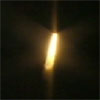
|
 |
Saturn's rosy tan moon
Unlike most of the dull grey moons in the Solar System, Hyperion's color is a rosy tan, as this view shows. The origin of the moon's unusual hue is not known. Some scientists suspect the color comes from falling debris from moons further out. A similar origin has been suggested for the dark reddish material on Saturn's moon Iapetus.
 FULL STORY FULL STORY
 |  |

|
 |
Boosting Enceladus' signal
The ice jets of Enceladus send particles streaming into space hundreds of kilometers above the south pole of this spectacularly active moon. Some of the particles escape to form the diffuse E ring around Saturn. This color-coded image was processed to enhance faint signals, making the contours and extent of the fainter, larger-scale component of the plume easier to see.
 FULL STORY FULL STORY
 |  |

|
 |
Atlantis crew ready to kick start station assembly
The crew of the shuttle Atlantis reviewed launch pad emergency procedures Wednesday and in a brief question-and-answer session with reporters, described their upcoming station assembly flight as one of the most complex missions yet attempted.
 FULL STORY FULL STORY
 |  |

|
 |

Additional coverage for subscribers:
 VIDEO:
LAUNCH PAD PRESS CHAT DIAL-UP | BROADBAND VIDEO:
LAUNCH PAD PRESS CHAT DIAL-UP | BROADBAND
 MORE: STS-115 VIDEO COVERAGE MORE: STS-115 VIDEO COVERAGE
 SUBSCRIBE NOW SUBSCRIBE NOW

|
Test team breaks its own record with C-17 drop
A government and industry test team recently released a full-scale simulated 72,000-pound rocket from an unmodified C-17A aircraft at the operational launch altitude of 32,000 feet and an air speed of 200 knots. The test was conducted as part of the Falcon Small Launch Vehicle Program.
 FULL STORY FULL STORY
 |  |

|
 |
Hubble finds stellar companion of distant planet
NASA's Hubble Space Telescope has for the first time identified the parent star of a distant planet discovered through gravitational microlensing. Microlensing occurs when a foreground star amplifies the light of a background star that momentarily aligns with it.
 FULL STORY FULL STORY
 |  |

|
 |
Chandra independently determines Hubble constant
A critically important number that specifies the expansion rate of the Universe, the so-called Hubble constant, has been independently determined using NASA's Chandra X-ray Observatory. This new value matches recent measurements using other methods and extends their validity to greater distances, thus allowing astronomers to probe earlier epochs in the evolution of the Universe.
 FULL STORY FULL STORY
 |  |

|
 |
Astronauts arrive at Cape for practice countdown
The crew of the shuttle Atlantis flew to the Kennedy Space Center Monday for launch-site training and to participate in a dress-rehearsal countdown Thursday that will set the stage for blastoff Aug. 27 on a space station construction mission.
 FULL STORY FULL STORY
 |  |

|
 |
Burst monitor closer to tracking explosions
NASA scientists and engineers have completed final testing and integration of the GLAST Burst Monitor, a space-based instrument for studying gamma ray bursts. Scientists think these bursts originate in the collapse of massive stars up to 100 times that of our sun, a process that eventually forms a black hole in space and poses unanswered questions to scientists on Earth.
 FULL STORY FULL STORY
 |  |
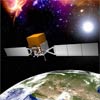
|
 |
Universe bigger than believed, astronomers say
An Ohio State University astronomer and his colleagues have determined that the Triangulum Galaxy is actually about 15 percent farther away from our galaxy than previously measured. This finding implies that the Hubble constant, a number that astronomers rely on to calculate a host of factors -- including the size and age of the universe -- could be significantly off the mark as well.
 FULL STORY FULL STORY
 |  |

|
 |
Research says pre-life molecules present in comets
Evidence of atomic nitrogen in interstellar gas clouds suggests that pre-life molecules may be present in comets, a discovery that gives a clue about the early conditions that gave rise to life. The finding also substantially changes the understanding of chemistry in space.
 FULL STORY FULL STORY
 |  |

|
 |
Proton lofts European broadcasting satellite
Eutelsat's Hot Bird 8 communications spacecraft was successfully carried aloft Friday night during a 9-hour flight that resumed commercial launches for Russia's Proton rocket fleet after a failure five months ago.
 MISSION STATUS CENTER MISSION STATUS CENTER
 |  |

|
 |
NASA rules out moving up Atlantis launch date again
NASA managers Thursday decided to stick with an August 27 launch target for shuttle Atlantis based on an analysis that indicates orbital lighting would not be sufficient for a launch on August 26.
 FULL STORY FULL STORY
 |  |

|
 |
Cosmic dust sheds light on Earth's past climate
Each year nearly 40,000 tons of cosmic dust fall to Earth from outer space. Now, the first successful chronological study of extraterrestrial dust in Antarctic ice has shown that this amount has remained largely constant over the past 30,000 years, a finding that could help refine efforts to understand the timing and effects of changes in the Earth's past climate.
 FULL STORY FULL STORY
 |  |
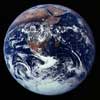
|
 |
Five decades of defense weather satellite service
"Weather" it's a hurricane, typhoon or thunderstorm in the constantly changing environment of global weather conditions, agencies behind the scenes continually provide data for distribution to Department of Defense and civilian government agencies.
 FULL STORY FULL STORY
 |  |

|
 |
Space station astronauts complete spacewalk
International Space Station residents Jeff Williams and Thomas Reiter went outside for a spacewalk Thursday. The six-hour excursion began at 10:04 a.m. and ended at 3:58 p.m. EDT. They installed an electrical charge measuring probe, deployed a pair of science packages, replaced a motor controller and a computer needed to operate cooling system radiators, removed a GPS antenna, adjusted some umbilical connectors, installed an exterior light, tested an infrared camera, installed a vent device and relocated spacewalk work platforms.
 PREVIEW STORY PREVIEW STORY
 |  |

|
 |
Space shuttle Atlantis rolls to the launch pad
Finally catching a break from the weather, the shuttle Atlantis was hauled to its ocean-side launch pad early Wednesday for final preparations before blastoff at the end of the month on a space station assembly mission.
 FULL STORY FULL STORY
 MISSION STATUS CENTER MISSION STATUS CENTER
 MASTER FLIGHT PLAN MASTER FLIGHT PLAN
 LAUNCH WINDOWS CHART LAUNCH WINDOWS CHART
 MISSION QUICK-LOOK: Page 1 | Page 2 MISSION QUICK-LOOK: Page 1 | Page 2
 REMAINING SHUTTLE LAUNCH SCHEDULE REMAINING SHUTTLE LAUNCH SCHEDULE
 |  |

|
 |

Additional coverage for subscribers:
 VIDEO:
ATLANTIS ARRIVES AT LAUNCH PAD 39B PLAY VIDEO:
ATLANTIS ARRIVES AT LAUNCH PAD 39B PLAY
 VIDEO:
ROLLOUT FROM VEHICLE ASSEMBLY BUILDING BEGINS PLAY VIDEO:
ROLLOUT FROM VEHICLE ASSEMBLY BUILDING BEGINS PLAY

 VIDEO:
TRUSS IN PAD'S PAYLOAD ROOM PLAY VIDEO:
TRUSS IN PAD'S PAYLOAD ROOM PLAY
 VIDEO:
PAYLOAD HOISTED INTO THE PAD PLAY VIDEO:
PAYLOAD HOISTED INTO THE PAD PLAY
 VIDEO:
STATION TRUSS PAYLOAD DELIVERED TO PAD PLAY VIDEO:
STATION TRUSS PAYLOAD DELIVERED TO PAD PLAY
 MORE: STS-115 VIDEO COVERAGE MORE: STS-115 VIDEO COVERAGE
 SUBSCRIBE NOW SUBSCRIBE NOW

|
A simple survey yields a cosmic conundrum
A survey of galaxies observed along the sightlines to quasars and gamma-ray bursts -- both extremely luminous, distant objects -- has revealed a puzzling inconsistency. Galaxies appear to be four times more common in the direction of gamma-ray bursts than in the direction of quasars.
 FULL STORY FULL STORY
 |  |

|
 |
OTHER HEADLINES Additional stories today
|
 |
Faintest object beyond solar system observed -- As part of an ongoing search for Earth's nearest stellar neighbors, astronomers have determined the distance to a stellar-like body and discovered that it is the nearest-known L dwarf. This body is now also the faintest object outside our solar system for which its intrinsic visual brightness has been measured.

Dark energy mission picked for concept development -- A Johns Hopkins astrophysicist is principal investigator of a proposal, accepted Tuesday by NASA, to design a space mission to determine the properties of the mysterious dark energy that is causing the expansion rate of the universe to speed up. Called the Advanced Dark Energy Physics Telescope (ADEPT), the mission promises to determine the location of 100 million galaxies.

NASA picks teams for space weather mission and studies -- Four university teams will share $100 million to provide experiments and supporting hardware for a future NASA mission to study near-Earth space radiation. This type of radiation is hazardous to astronauts, orbiting satellites and aircraft flying high altitude polar routes.
|
 |
|
Read our earlier news archive page.
|



